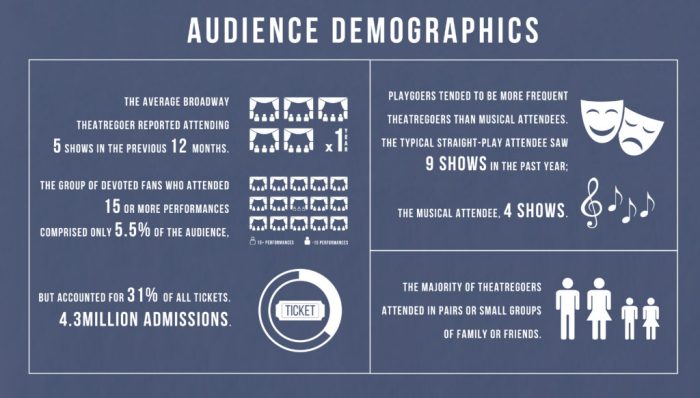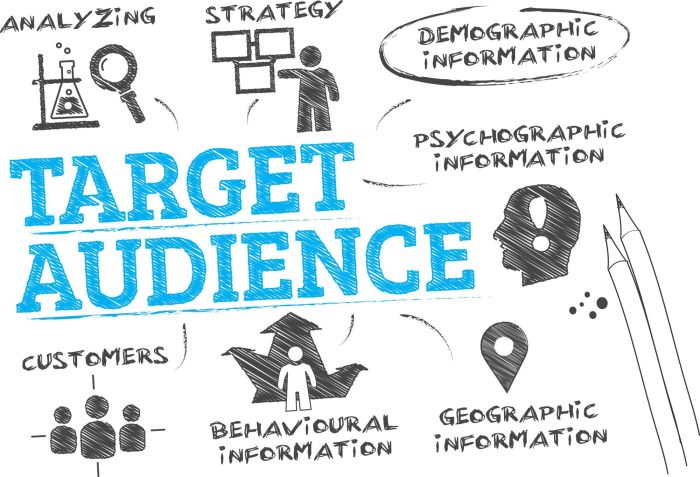Understanding Audience Demographics sets the stage for businesses to tailor their strategies to reach the right people effectively. From age to purchasing habits, dive into the world of audience insights and its impact on decision-making.
Importance of Understanding Audience Demographics
Understanding audience demographics is like having the secret sauce for businesses and marketers. It’s all about knowing who your customers are, what they like, and how to reach them effectively. Without this crucial information, businesses would be shooting in the dark, wasting time and money on marketing strategies that may not resonate with their target audience.
Influencing Marketing Strategies
When businesses have a clear understanding of their audience demographics, they can tailor their marketing strategies to speak directly to their target market. For example, if a company knows that a majority of their customers are young adults who are active on social media, they can focus their marketing efforts on platforms like Instagram or TikTok. This targeted approach increases the chances of reaching the right people with the right message, leading to higher engagement and conversion rates.
Impact on Product Development and Customer Service
Audience demographics play a significant role in shaping product development and customer service. By understanding the preferences and needs of their target audience, businesses can create products that align with their customers’ expectations. For instance, if a company’s demographic data shows that their customers value sustainability, they can develop eco-friendly products to meet that demand. Additionally, knowing the demographics of their customers allows businesses to provide personalized customer service experiences, catering to the specific needs of different customer segments.
Types of Audience Demographics
When it comes to understanding audience demographics, it’s essential to consider a variety of factors that can provide valuable insights into the characteristics of your target audience. These factors can help you tailor your marketing strategies to better reach and engage with your audience. Let’s explore the key types of audience demographics below.
Key Demographic Factors
- Age: Age plays a crucial role in defining the preferences and behaviors of individuals. Different age groups may have varying interests and needs.
- Gender: Gender can influence purchasing decisions and brand preferences. Understanding the gender distribution of your audience can help you create more targeted campaigns.
- Income: Income levels can impact the affordability and willingness to purchase certain products or services.
- Education: Education levels can affect the values, interests, and lifestyles of individuals, shaping their consumer behavior.
- Location: Geographic location can influence cultural norms, preferences, and access to products or services.
Psychographic Factors Impacting Audience Demographics
- Values: Understanding the values that drive your audience can help you align your brand messaging and offerings with what matters most to them.
- Interests: Identifying the interests of your audience can guide content creation and product development to cater to their specific preferences.
- Lifestyles: Lifestyle choices, such as hobbies, social activities, and spending habits, can provide insights into how your audience lives and interacts with the world.
Significance of Behavioral Factors in Audience Demographics, Understanding Audience Demographics
- Purchasing Habits: Analyzing the buying patterns of your audience can help you anticipate their needs and tailor your marketing strategies accordingly.
- Brand Loyalty: Understanding the level of loyalty your audience has towards your brand or competitors can influence customer retention and acquisition efforts.
- Online Behavior: Monitoring how your audience interacts with your online platforms can provide valuable data on engagement levels, preferences, and areas for improvement.
Methods for Collecting Audience Demographics: Understanding Audience Demographics

When it comes to gathering audience demographics, there are various methods that can be utilized to obtain valuable data about your target audience. Traditional methods such as surveys, focus groups, and interviews have been commonly used for collecting demographic information. In addition to these traditional methods, analytics tools and social media insights play a significant role in understanding the demographics of your audience.
It is important to consider data privacy and ethical considerations when collecting demographic information to ensure the protection of individuals’ personal information.
Traditional Methods for Collecting Audience Demographics
- Surveys: Surveys are a popular method for collecting demographic data as they allow you to directly ask your audience questions about their age, gender, income, education level, and more.
- Focus Groups: Focus groups involve gathering a small group of individuals to discuss specific topics related to your audience demographics, allowing for in-depth insights and feedback.
- Interviews: Conducting interviews with individuals can provide valuable qualitative data about their preferences, behaviors, and demographics.
Role of Analytics Tools and Social Media Insights
- Analytics Tools: Tools like Google Analytics, Facebook Insights, and other data analytics platforms can provide valuable information about the demographics of your website visitors or social media followers.
- Social Media Insights: Social media platforms offer insights into the demographics of your audience, including age, gender, location, interests, and more, helping you tailor your content to better suit their preferences.
Data Privacy and Ethical Considerations
- Protecting Data Privacy: It is crucial to ensure that the data collected is kept secure and that individuals’ personal information is not shared without their consent.
- Ethical Considerations: Respecting individuals’ privacy and being transparent about how their data will be used is essential when collecting demographic information to maintain trust with your audience.
Analyzing and Utilizing Audience Demographics

Understanding audience demographics is crucial for businesses to tailor their marketing campaigns effectively. By analyzing demographic data, businesses can create targeted strategies that resonate with specific groups of people.
Creating Targeted Marketing Campaigns
When analyzing audience demographics, businesses can segment their target market based on factors like age, gender, location, income level, and interests. By identifying common characteristics among different demographic groups, businesses can create personalized marketing campaigns that speak directly to their target audience.
- For example, a clothing brand targeting young adults can analyze demographic data to understand the preferences and buying habits of this age group. With this information, the brand can create ad campaigns that feature trendy styles and social media influencers that appeal to their target demographic.
- Similarly, a local restaurant can use demographic data to target customers in nearby neighborhoods with personalized promotions and offers based on their income level and dining preferences.
Influencing Content Creation and Messaging
Demographic data can also shape the content and messaging businesses use to engage with their audience. By understanding the values, interests, and communication preferences of different demographic groups, businesses can create content that resonates with their target market.
- For instance, a travel agency targeting older adults may use nostalgic imagery and testimonials to appeal to their desire for comfort and relaxation, while a tech company targeting younger generations may use bold visuals and interactive content to capture their attention.
- By tailoring content to specific demographics, businesses can establish a connection with their audience and foster brand loyalty.
Enhancing Customer Engagement with Personalized Experiences
Personalized experiences based on demographic data can significantly enhance customer engagement. By delivering targeted content, promotions, and recommendations that align with the preferences of different demographic groups, businesses can create a more personalized and memorable experience for their customers.
- For example, an e-commerce website can use demographic data to recommend products based on a customer’s age, location, and past purchase history, increasing the likelihood of a purchase.
- Similarly, a fitness app can tailor workout plans and nutrition tips to the specific goals and fitness levels of its users, leading to a more engaging and effective user experience.
